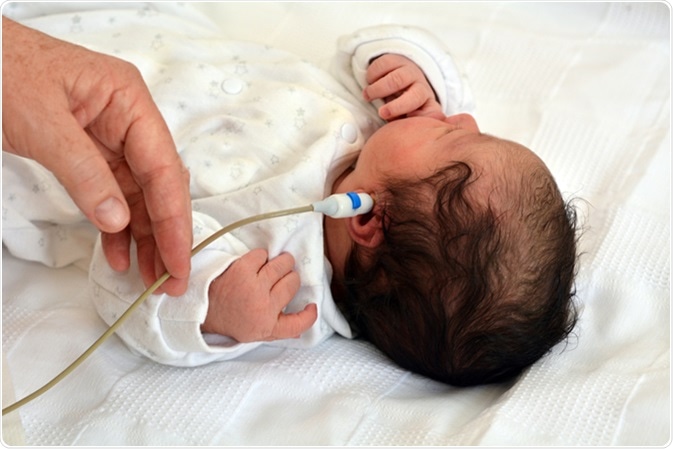Newborn hearing should and can be screened in order to detect severe-to-profound hearing loss. This was the conclusion of the life work of the renowned audiologist Marion Downs.
In 1964 she discovered the importance of an early assessment of newborn hearing. Her reported incidence of this type of auditory loss was 1 in 1,000 infants.
The total incidence of hearing loss, including lower degrees of deafness which were still of practical significance, was three times as high.

Newborn Infant during hearing screening. Significant hearing loss is the most common disorder at birth. Approximately 1%-2% of newborns are affected. Image Credit: ChameleonsEye / Shutterstock
Downs also showed that non-invasive testing could be of use to non-professional persons to detect hearing loss. In addition educationists determined the high value of early detection of deafness in the context of educational outcomes in this class of infants.
Against this background, the NIH introduced the program of universal screening of newborn infants for hearing loss which developed and spread to its present extent.
The early development of communication pathways in the brain is fundamental to this improvement, whether by speech, sign language, or both. An early understanding and using of spoken or signed, and written, language, is critical to proper development of the language, auditory and speech areas of the brain.
Newborn hearing screenings
Types of Testing
The techniques used at present to test hearing in infants are:
- Automated auditory brainstem response (ABR) which measures the average response registered by a neuron in response to a repeated auditory signal.
- Otoacoustic emission (OAE) testing which detects sound by the stimulation of the cochlear cells.
These may be used individually or together in a two-stage manner. However, the otoacoustic signals may remain unaltered in patients with auditory nerve dysfunction, even though the ABR is abnormal. Thus if OAE is used only as a confirmatory second-stage test, changes in the ABR alone may not be picked up.
Incidence of Hearing Loss
In the US, 1.86 per 1000 newborns suffer from unilateral or bilateral hearing loss compared to 1.33 per 1000 in the UK.
Results
With early testing programs, about 2-4 percent of newborns failed to hear; however, with confirmatory testing, up to 90 percent of these infants were found to have normal hearing. This led to the criticism that the testing aroused unnecessarily high levels of anxiety on the part of the parents.
Over time, the programs have improved in accuracy of testing to the point that the failure rate among newborns is now only 0.5 percent. Of these, approximately half the infants actually have hearing loss. Thus deafness is now being picked up at the age of 2-3 months in contrast to the earlier age of 24-30 months on average. This has led to a striking improvement in language and social skills as well as emotional development in these children to normal levels, because of the early commencement of remedial training and treatment, before the age of 6 months.
The placement of cochlear implants, for instance, saves up to $200 000 in special education costs.
As a result of this early intervention, all states in the US have established these programs termed Early Hearing Detection and Intervention (EHDI) which cover about 95 percent of newborns.
References
Further Reading
Last Updated: Dec 29, 2022